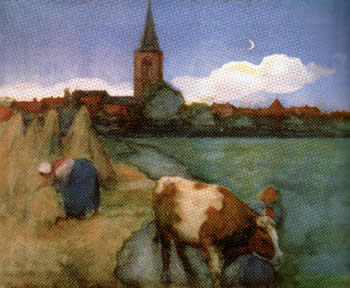 View of Winterswijk (1899).
View of Winterswijk (1899).
He tried several times to win the Prix de Rome, the most prestigious prize in Netherlands. He failed miserably! The jury, unfortunately, had remained entrenched in the old, academic paintings, and rejected him.
For Mondrian, this was a difficult time where he stood little chance of selling any of his paintings and for a brief while he joined a group of radicals, until there was a major strike of railway workers that led to bloodshed. At this point, Mondrian left Amsterdam and returned to the country and resumed landscape painting in the traditional Dutch style. His street corners gave way to Brabant windmills, cows in pasture and other subjects that are quintessentially Dutch and are still typified to this day. Mondrian knew what the public wanted to see, and that is what he gave them.
It was around 1906 that Mondrian’s own style began to change. Van Gogh had started to come into fashion, and Mondrian used some of his ideas in his own paintings, reflected at this time of his life. The use of van Gogh’s own ideas in his work is more Mondrian’s will to make himself a great artist, rather than his own perception of his world.
In copying the Romantics, Mondrian saw that the paintings were becoming references to other paintings, and were losing much of what they wanted to achieve. The new world of the cloned landscape motifs attracted him strongly and he found it far more interesting; offering a new way to look at artificial life in the realm of art.